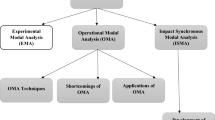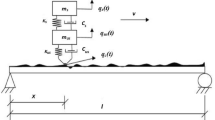Abstract
This paper proposes a new output-only element-level system identification and input estimation technique, towards the simultaneous identification of modal parameters, input excitation time history and structural features at the element-level by adopting earthquake-induced structural response signals. The method, named Full Dynamic Compound Inverse Method (FDCIM), releases strong assumptions of earlier element-level techniques, by working with a two-stage iterative algorithm. Jointly, a Statistical Average technique, a modification process and a parameter projection strategy are adopted at each stage to achieve stronger convergence for the identified estimates. The proposed method works in a deterministic way and is completely developed in State-Space form. Further, it does not require continuous- to discrete-time transformations and does not depend on initialization conditions. Synthetic earthquake-induced response signals from different shear-type buildings are generated to validate the implemented procedure, also with noise-corrupted cases. The achieved results provide a necessary condition to demonstrate the effectiveness of the proposed identification method.












Similar content being viewed by others
References
Au SK, Zhang FL (2016) Fundamental two-stage formulation for Bayesian system identification part I: general theory. Mech Syst Signal Process 66–67:31–42
Beck J, Jennings P (1980) Structural identification using linear models and earthquake recordings. Earthq Eng Stuct Dyn 8(2):145–160
Beck J (1982) System identification applied to strong motion records from structures. In: Datt SK (ed) Earthquake ground motion and its effects on structures. ASME Publications AMD-53, New York, pp 109–134
Behmanesh I, Moaveni B, Lombaert G, Papadimitriou C (2015) Hierarchical Bayesian model updating for structural identification. Mech Syst Signal Process 64–65:360–376
Benedetti D, Gentile C (1994) Identification of modal quantities from two earthquake responses. Earthq Eng Stuct Dyn 23(4):447–462
Brincker R, Zhang L, Andersen P (2001) Modal identification of output-only systems using Frequency Domain Decomposition. Smart Mater Struct 10(3):441–445
Celebi M, Phan LT, Marshall RD (1993) Dynamic characteristics of five tall buildings during strong and low-amplitude motions. Struct Design Tall Build 2(1):1–15
Chen J, Li J, Xu YL (2002) Simultaneous estimation of structural parameter and earthquake excitation from measured structural response, Proceeding of the International Conference on Advances and New Challenges in Earthquake Engineering Research (ICANCEER 2002), 3:537–544, 15-20 August 2002, Hong Kong, China
Chen J, Li J (2004) Simultaneous identification of structural parameters and input time history from output-only measurements. Comput Mech 33(5):365–374
Cho HN, Paik SW (2000) Time domain system identification technique with unknown input and limited observation. In: Proceeding of the 8th ASCE Specialty Conference on Probabilistic Mechanics and Structural Reliability (PMC2000), 1:1–6, 24–26 July 2000, Notre Dame, Indiana, United States
Chopra AK (2012) Dynamics of structures: theory and applications to earthquake engineering, 4th edn. Prentice Hall, Englewood Cliffs
Concha A, Icaza LA, Garrido R (2016) Simultaneous parameters and state estimation of shear buildings. Mech Syst Signal Process 70:788–810
Datta TK (2010) Seismic analysis of structures. Wiley, New York
Ding Y, Zhao BL, Wu B (2014) Structural system identification with Extended Kalman Filter and orthogonal decomposition of excitation, Mathematical Problems in Engineering, vol 2014, Article ID 987694, 10 p. doi:10.1155/2014/987694
Durbin J, Koopman S (2001) Time series analysis by state space methods. Oxford University Press, Oxford
Doebling S, Farrar C (1999) The state of the art in structural identification of constructed facilities. Report by the ASCE Committe on Structural Identification of Constructed Facilities, New York
Ghahari S, Abazarsa F, Ghannad M, Taciroglu E (2013) Response-only modal identification of structures using strong motion data. Earthq Eng Struct Dyn 42(11):1221–1242
Gomez H, Ulusoy H, Feng M (2013) Variation of modal parameters of a highway bridge extracted from six earthquake records. Earthq Eng Struct Dyn 42(4):565–579
Haldar A, Ling X, Wang D (1997) Nondestructive identification of existing structures with unknown input and limited observations, Proceeding of the 7th International Conference on Structural Safety and Reliability (ICCOSAR 97), 1:363–370, 24–28 Nov 1997, Kyoto, Japan
Hegde G, Sinha R (2008) Parameter identification of torsionally coupled shear buildings from earthquake response records. Earthq Eng Struct Dyn 37(11):1313–1331
Hoshiya M, Sutoh A (1984) Structural identification by extended Kalman Filter. J Eng Mech ASCE 110(12):1757–1770
Hoshiya M, Sutoh A (1995) Identification of input and parameters of a MDOF system, Building for the 21st Century: Proceeding of the 5th East Asia-Pacific Conference on Structural Engineering and Construction (EASEC-5), 3:1309–1314, 25–27 July 1995, Griffith, Australia
Huang C, Lin H (2001) Modal identification of structures from ambient vibration, free vibration, and seismic response data via a subspace approach. Earthq Eng Struct Dyn 30(12):1857–1878
Jiménez R, Icaza LA (2007) A real-time estimation scheme for buildings with intelligent dissipation devices. Mech Syst Signal Process 21(6):2427–2440
Lamarche C, Paultre P, Proulx J, Mousseau S (2008) Assessment of the Frequency Domain Decomposition technique by forced-vibration tests of a full-scale structure. Earthq Eng Struct Dyn 37(3):487–494
Lawson CL, Hanson RJ (1974) Solving least squares problems. Prentice Hall, Englewood Cliffs
Lei Y, Tang YL, Wang JX, Jiang YQ, Luo Y (2012) Intelligent monitoring of multistory buildings under unknown earthquake excitation by a wireless sensor network, International Journal of Distributed Sensor Networks, vol 2012, Article ID 914638, 14 p. doi:10.1155/2012/914638
Li J, Chen J (1997) Inversion of ground motion with unknown structural parameters (in Chinese). Earthq Eng Eng Vib 17(3):27–35
Li J, Chen J (2000), Structural parameters identification with unknown input, Proceeding of 8th International Conference on Computing in Civil and Building Engineering (ICCCBE-VIII), 1:287–293, 14–16 August 2000, Stanford, California, United States
Li J, Chen J (2003) A statistical average algorithm for the dynamic compound inverse problem. Comput Mech 30(2):88–95
Lin C, Hong L, Ueng Y, Wu K, Wang C (2005) Parametric identification of asymmetric buildings from earthquake response records. Smart Mater Struct 14(4):850–861
Ling X, Haldar A (2004) Element level system identification with unknown input with Rayleigh damping. J Eng Mech ASCE 130(8):877–885
Lourens E, Papadimitriou C, Gillijns S, Reynders E, De Roeck G, Lombaert G (2012) Joint input-response estimation from structural systems based on reduced-order models and vibration data from a limited number of sensors. Mech Syst Signal Process 29:310–327
Mahmoudabadi M, Ghafory-Ashtiany M, Hosseini M (2007) Identification of modal parameters of non-classically damped linear structures under multi-component earthquake loading. Earthq Eng Struct Dyn 36(6):765–782
Michel C, Guéguen P, El Arem S, Mazars J, Panagiotis K (2010) Full-scale dynamic response of an RC building under weak seismic motions using earthquake recordings, ambient vibrations and modelling. Earthq Eng Structl Dyn 39(4):419–441
Ott N, Meder HG (1972) The Kalman filter as a prediction error filter. Geophys Prospect 20(3):549–560
Perry MJ, Koh CG, Choo YS (2006) Modified genetic algorithm strategy for structural identification. Comput Struct 84(8):529–540
Perry MJ, Koh CG (2008) Output-only structural identification in time domain: numerical and experimental studies. Earthq Eng Struct Dyn 37(4):517–533
Pioldi F, Ferrari R, Rizzi E (2015) Output-only modal dynamic identification of frames by a refined FDD algorithm at seismic input and high damping. Mech Syst Signal Process 68–69:265–291. doi:10.1016/j.ymssp.2015.07.004
Pioldi F, Ferrari R, Rizzi E (2015) Earthquake structural modal estimates of multi-storey frames by a refined FDD algorithm. J Vib Control. doi:10.1177/1077546315608557, available on line
Pioldi F, Ferrari R, Rizzi E (2015) Earthquake FDD modal identification of current building properties from real strong motion structural response signals, Submitted for publication
Pioldi F, Rizzi E (2015) A refined Frequency Domain Decomposition tool for structural modal monitoring in earthquake engineering, Submitted for publication
Pioldi F, Salvi J, Rizzi E (2015) FDD modal identification from earthquake response data with evaluation of Soil-Structure Interaction effects, Proceeding of 1st International Conferene on Engineering Vibration (ICoEV2015), ISBN: 978-961-6536-97-4, 1:412–421, 7–10 September 2015, Ljubljana, Slovenia
Pridham B, Wilson J (2004) Identification of base-excited structures using output-only parameter estimation. Earthq Eng Struct Dyn 33(1):133–155
Singh JP, Agarwal P, Kumar A, Thakkar SK (2014) Identification of modal parameters of a multistoried RC building using ambient vibration and strong vibration records of Bhuj eartquake. J Earthq Eng 18(3):444–457
Smyth A, Pei J, Masri S (2003) System identification of the Vincent Thomas Bridge using earthquakes records. Earthq Eng Struct Dyn 32(3):339–367
Toki K, Sato T, Kiyono J (1989) Identification of structural parameters and input ground motion from response time histories, Proceeding of the Japan Society of Civil Engineers-Structural and Earthquake Eng. N.410/I12, 6(2):413–421
Ulusoy H, Feng M, Fanning P (2011) System identification of a building from multiple seismic records. Earthq Eng Struct Dyn 40(6):661–674
Ventura CE, Brincker R, Andersen P (2005) Dynamic properties of the Painter Street Overpass at different levels of vibration, Proceeding of the 6th Internation Conference on Structural Dynamics (EURODYN), 1:167–172, 4–7 Sept. 2005, Paris, France
Villaverde R, Koyama LA (1993) Damped resonant appendages to increase inherent damping in buildings. Earthq Eng Struct Dyn 22(6):491–507
Wang D, Haldar A (1994) Element-level system identification with unknown input. J Eng Mech ASCE 120(1):159–176
Wang XJ, Cui J (2008) A two-step method for structural parameter identification with unknown ground motion, Proceeding of the 14th World Conference on Earthquake Engineering (14-WCEE), 1:12–19, 12–17 October 2008, Beijing, China
Zhang FL, Au SK (2016) Fundamental two-stage formulation for Bayesian system identification part II: application to ambient vibration data. Mech Syst Signal Process 66–67:43–61
Zhao X, Xu YL, Chen J (2006) Hybrid identification method for multi-story buildings with unknown ground motion: theory. J Sound Vib 291(1):215–239
Acknowledgments
The Authors would like to acknowledge public research support from “Fondi di Ricerca d’Ateneo ex 60 %” and a ministerial doctoral grant and funds at the ISA Doctoral School, University of Bergamo, Department of Engineering and Applied Sciences (Dalmine).
Author information
Authors and Affiliations
Corresponding author
Rights and permissions
About this article
Cite this article
Pioldi, F., Rizzi, E. A Full Dynamic Compound Inverse Method for output-only element-level system identification and input estimation from earthquake response signals. Comput Mech 58, 307–327 (2016). https://doi.org/10.1007/s00466-016-1292-0
Received:
Accepted:
Published:
Issue Date:
DOI: https://doi.org/10.1007/s00466-016-1292-0




